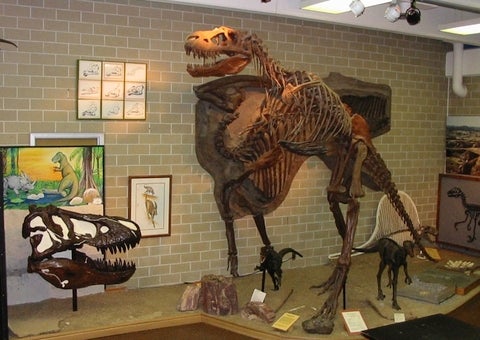Our mission and vision
Bringing the science of planet Earth into the lives and careers of all by sharing knowledge and raising awareness for the Earth, its history, its resources, and the environmental issues facing society.
The Earth Sciences Museum aspires to foster in visitors an appreciation and understanding of the Earth’s environments, materials, and processes, while facilitating awareness of the intricate human connections to them.
Our history
- 2014
-
2013
-
Jim Reimer donates a new piece of petrified wood from Arizona to the museum collection.
-
A cast of Mistaken Point, a fossil site in Newfoundland, is installed in the atrium.
-
Barry Warner, Chair of the Earth sciences department, visited the new graphite mine in Kearney, where he was able to find a beautiful piece of graphite gneiss to add to the Peter Russell Rock Garden.
Warner travelled to Nipple Mountain, near Kelowna in British Columbia, this same year, where he acquired columnar basalt and dacite for the Peter Russell Rock Garden collection. These volcanic columns are of Paleogene age and within the basalt there are fragments of peridotite.
-
The Peter Russell Rock Garden voted best outdoor space on campus.
-
-
2012
-
Amethyst artwork by artist Norm Couvrette of Rogue Metal Art, Tuscon, Arizona is installed in the Conestoga Rovers Learning Centre in July. The amethyst geode used in this piece is from Rio De Sol, Brazil.
-
A gold weigh scale, once used by the Royal Canadian Mint, was donated to the museum by the Dynamic Earth Museum in Sudbury. It was later installed in a glass case by the west-facing doors of EIT.
-
Wayne DeBrusk of Shuniah Township near Thunder Bay donates stromatolitic limestone to the museum. The boulder was installed in the Peter Russell Rock Garden.
-
The Cobalt Discovery Mine Tunnel exhibit officially opens on October 27, 2012.
-
-
2003
-
The museum moved to the Centre for Environmental and Information Technology (EIT) in August 2003. The unique facilities were optimized to accommodate museum exhibits.
-
- 2001
-
1999
-
The Geological Garden was renamed the Peter Russell Rock Garden in recognition of Russell’s contributions to the university.
-
-
1996
-
The Biology department withdrew its involvement and the museum was renamed the Earth Sciences Museum.
-
-
1987
-
The Geological Garden officially opened on May 29, 1987 with 23 rock specimens representative of several different geological formations found in Ontario.
-
-
1981
-
The Geological Garden (later, the Peter Russell Rock Garden) was established to commemorate the 25th anniversary of the University of Waterloo.
-
-
1968
-
The museum opened to the public. It was initially housed in two rooms in Biology One and had a total floor area of 280 square metres.
-
-
1967
-
The Earth Sciences Museum, originally the Biology Earth Sciences Museum, was founded as a Canadian Centennial project. Funding was provided by the University of Waterloo and the Ontario Ministry of Culture.
-

The Conestoga Rovers Learning Centre represents a part of the Earth Sciences Museum as it is today.
The cast of Mistaken point (left) was installed in 2013 and the Mastodon mural (right) in 2014.

Peter Russel and Shirley Chatten in front of the new Amethyst artwork by artist Norm Couvrette in July 2012.
Construction of the Cobalt Mining Tunnel, 2011.

Peter Russell (right) and Leanne Taylor (left) with mining equipment courtesy of the Cobalt Historical Society. Taylor, a University of Waterloo alumni, arranged for the acquisition of this equipment while on a work term in Cobalt in 2008. It was the seed that started the Mine Tunnel Project!

The Earth Sciences Museum before moving to the new space in 2003.











